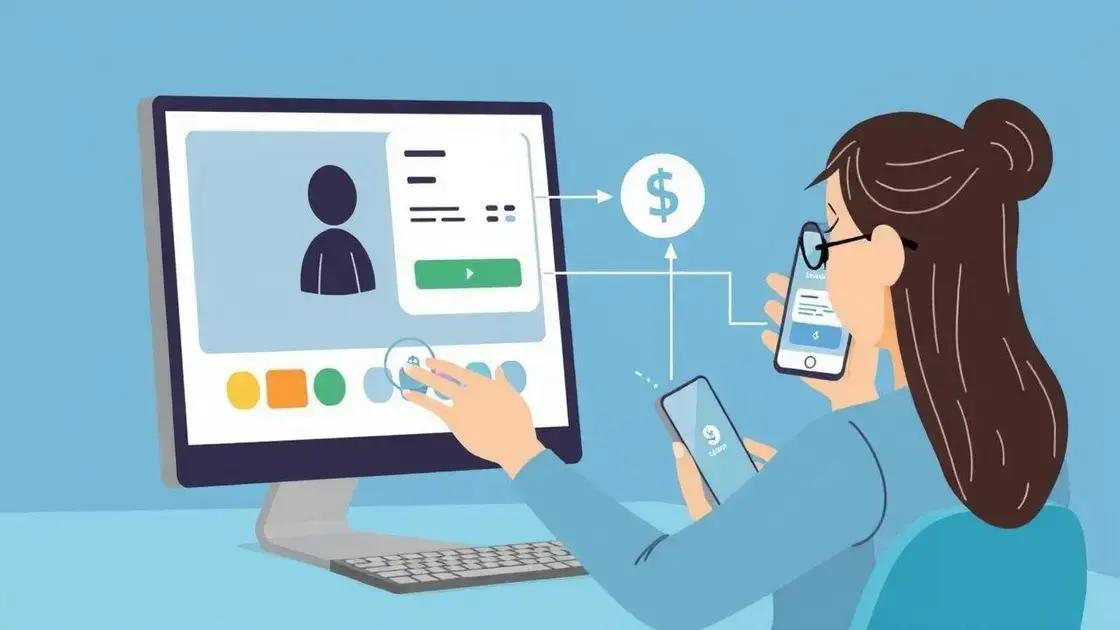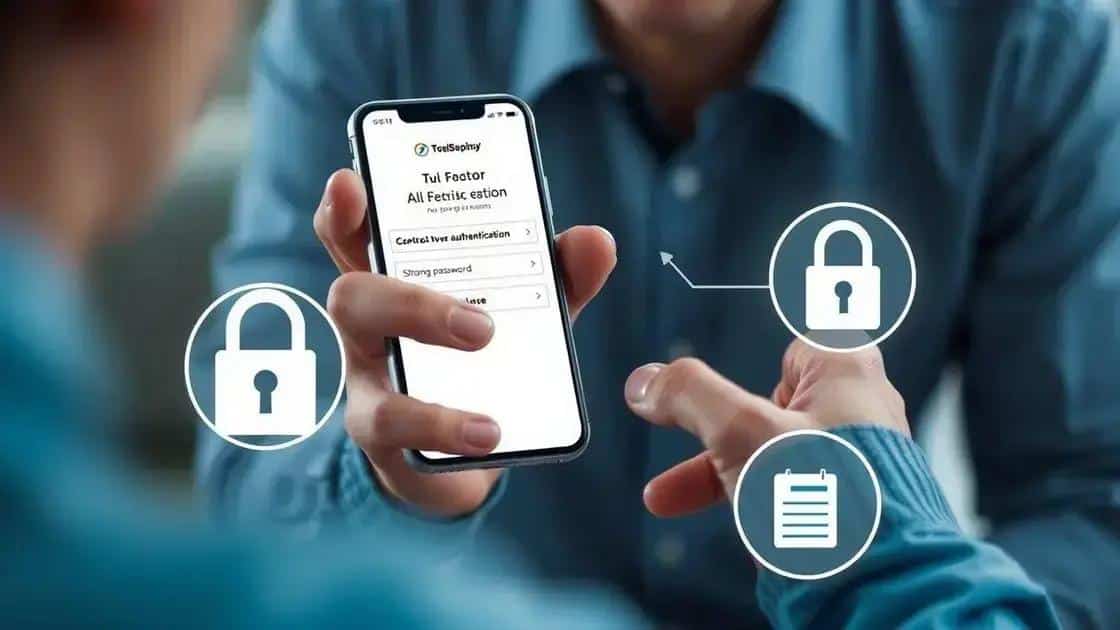Peer-to-Peer payment fraud prevention tips you need

To prevent peer-to-peer payment fraud, enhance your security by using strong passwords, enabling two-factor authentication, monitoring transactions closely, and reporting any suspicious activity immediately.
Peer-to-peer payment fraud prevention tips are crucial in today’s digital landscape. Have you ever wondered how to keep your money safe while transferring funds online? In this article, we’ll share valuable strategies to help you navigate these transactions securely.
Understanding peer-to-peer payment fraud
Understanding peer-to-peer payment fraud is essential for anyone using these services. It can happen in various ways, and being aware of the risks can help protect your finances.
First, let’s look at some common methods fraudsters use to exploit users. These tactics are often quite clever, designed to trick unsuspecting individuals into revealing personal information.
Common methods of peer-to-peer payment fraud
1. Impersonation scams: Scammers may pose as someone you know, like a friend or family member, asking for a payment. They often do this through social media or email.
2. Fake marketplaces: Be cautious when buying or selling items online through peer-to-peer platforms. Dishonest sellers can take your money without delivering the product.
3. Phishing attempts: These are messages that look like they come from legitimate services but are designed to steal your account details.
Signs of peer-to-peer payment fraud
Watch for these red flags:
- Requests for payments to unfamiliar accounts.
- Messages with odd language or urgency from friends.
- Deals that seem too good to be true, especially from online ads.
If you notice any of these warning signs, trust your instincts. It’s better to be cautious than to risk losing money.
It’s also wise to educate yourself on how to use these payment platforms securely. For instance, enabling two-factor authentication can provide an extra layer of protection.
Lastly, always verify information from a trusted source before proceeding with any transaction. By staying informed and alert, you can enjoy the benefits of peer-to-peer payments while minimizing the risks.
Common signs of payment fraud
Recognizing the common signs of payment fraud is crucial for protecting your money. Awareness can empower you to act quickly and avoid financial loss.
Many individuals might overlook subtle hints that fraud is occurring. It’s essential to stay vigilant and informed about these indicators.
Unexpected requests for money
If you receive a message asking for money—especially if it seems urgent or out of the blue—it’s a red flag. Scammers often create a sense of urgency to pressure you into acting quickly without thinking.
Unusual account activity
Monitor your payment app for any transactions you don’t recognize. If you see payments to unknown individuals or amounts you didn’t authorize, it’s time to investigate further.
- Check for any unexplained charges.
- Look for transfers sent without your knowledge.
- Review your transaction history regularly.
Another warning sign is receiving messages or emails that seem off. Scammers often imitate legitimate companies, so be cautious of misspellings or unfamiliar sender addresses.
Sometimes, fraudsters might use social engineering tactics, trying to get personal information by pretending to be someone you trust. Always verify with that person through another means before sending money.
By knowing what to look for, you can stay one step ahead of fraudsters and protect your financial health. Remember, staying informed is your best defense against payment fraud.
Steps to enhance your security

Enhancing your security is vital to protect against peer-to-peer payment fraud. By taking proactive steps, you can safeguard your transactions and personal information.
First, always enable two-factor authentication (2FA) on your payment apps. This extra layer of security requires you to verify your identity with a second method, like a text message or authentication app. It greatly reduces the chances of unauthorized access.
Use strong passwords
Creating a unique and complex password is essential. Avoid using common words or easily guessable information, like your birthday. Using a mix of letters, numbers, and symbols can strengthen your password significantly.
Monitor your transactions
Regularly checking your transaction history is crucial. If you spot anything unusual, report it immediately. Many apps allow you to set up alerts for specific transactions, so you can be notified if anything unexpected occurs.
- Review your account daily or weekly.
- Set alerts for large transactions.
- Keep track of all pending transactions.
Another effective step is to be cautious when using public Wi-Fi. Avoid logging into your payment apps when connected to unsecured networks. If you need to access sensitive information, consider using a virtual private network (VPN) for better security.
Finally, always keep your apps updated. Developers frequently release security updates that protect against newer threats. Make it a habit to check for updates and install them promptly.
Best practices for safe transactions
Following best practices for safe transactions can help you avoid falling victim to fraud. Implementing these strategies can protect you and your money.
Start by verifying the recipient’s identity before sending money. This simple step ensures you know who you are dealing with, drastically reducing the risk of scams. If someone you don’t know asks for money, it’s essential to be cautious.
Use secure payment methods
Choose reputable peer-to-peer payment platforms. Make sure these services offer fraud protection and a solid customer service team. Always check reviews and ratings before deciding.
Keep your personal information private
Avoid sharing sensitive information, like passwords or credit card details, through messages or emails. Scammers often try to trick you into providing this information. Instead, communicate through secure channels if necessary.
- Only use official app channels.
- Steer clear of public Wi-Fi when making payments.
- Enable notifications for all transactions.
Always review your payment details carefully before completing any transaction. Double-check the amount and recipient information to prevent sending money to the wrong person. This small habit can save you from regrettable mistakes.
Furthermore, trusting your instincts is crucial. If something feels off, don’t proceed with the transaction. Take a moment to rethink the situation and gather more information.
Lastly, educate yourself about common scams. Understanding the various tactics used by fraudsters prepares you to recognize potential threats early, allowing you to act accordingly.
When to report suspicious activity
Knowing when to report suspicious activity is crucial in preventing fraud. If something seems off, it’s better to act quickly.
First, if you notice unexpected transactions on your payment app, it’s essential to report them immediately. Fraudsters can act quickly, so time is of the essence. Reach out to your bank or the payment service directly.
Signs to watch for
Be alert for red flags that indicate potential fraud:
- Unexpected charges that you did not authorize.
- Messages from unknown senders asking for money.
- Payments made to unfamiliar accounts or recipients.
Additionally, if you receive any phishing attempts, such as emails or texts that ask for personal information, report these as well. These messages are often designed to steal your sensitive data. Always verify the source before clicking on any links.
Document everything
When reporting suspicious activity, document all details. Take screenshots of transactions and save any correspondence. This information can help investigators trace fraudulent activities.
If your account was compromised, change your passwords immediately. Use strong, unique passwords for each account, and consider enabling two-factor authentication as an added security measure.
Lastly, don’t hesitate to inform friends and family about the scams you encountered. Sharing your experiences can help others avoid similar situations, increasing awareness about potential scams.
In conclusion, staying vigilant and informed about peer-to-peer payment fraud is essential for protecting your finances. By recognizing the signs of fraud, enhancing your security, and knowing when to report suspicious activity, you can significantly reduce the risk of falling victim to scams. Always remember to use secure payment methods, monitor your transactions closely, and share your knowledge with others. Together, we can create a safer online payment environment.
FAQ – Frequently Asked Questions about Peer-to-Peer Payment Fraud Prevention
What should I do if I notice a suspicious transaction?
Immediately report the transaction to your payment service provider. Acting quickly can help prevent further fraud.
How can I enhance my account security?
Use strong, unique passwords and enable two-factor authentication on your accounts to add an extra layer of protection.
What are common signs of payment fraud?
Look for unexpected requests for money, unauthorized charges, or messages from unknown sources asking for personal information.
Why is it important to educate others about payment fraud?
Sharing your knowledge can help friends and family recognize scams and stay safe, creating a more informed community.





